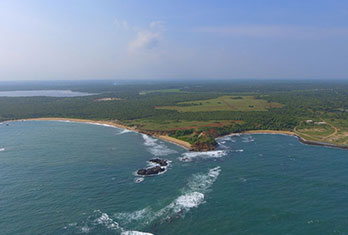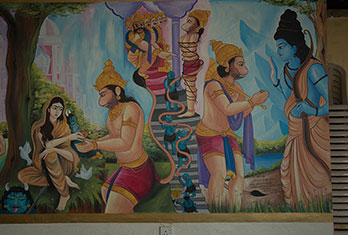- What's New
-
What to Do
-

Sun & Beach
This entire island gifted by shining blue water. Therefore, Sri Lanka is most popular for beaches among tourists. Read More
-

Sri Lankan Heritage
In Sri Lanka, you can discover rich and enormous cultural heritage. Read More
-

Adventure & Sports
In Sri Lanka, you can get experience in water base, air base, earth base and many kinds of activities. Read More
-
You can participate to Sri Lanka's cultural festivals and events, and it gives you to chance experience in unique cultural rituals.Read More
-
within this you can easily find out proper tour itineraries to explore the Sri Lanka.Read More
-
-
Where to Go
-

Mirissa Whale Watching
Blue whales are the biggest animal live on the earth and Mirissa is the one of most suitable spot to watch blue whales and other whales too. Read More
-

Yala National Park
This is the second largest national park in Sri Lanka.Yala is home to Asian elephants, leopards and variety of beautiful endemic birds. Read More
-

12 Things to Do in Colombo
Colombo is the commercial and financial capital of the Sri Lanka. This city filled with luxurious hotels,restaurants and many variety of attractions. Read More
-

Provincial Tourism
Sri Lanka have divergent nine provincials.Select what you most prefer provincial in here and travel like your own way. Read More
-

Southern Corridor
Many of gorgeous beaches are located in southern province of Sri Lanka and not at all, this city is home to ancient British and Dutch architectural buildings and many of ancient religious sites. Read More
-
Sri Lanka is the treasure of island for all tourists. You can discover variety of natural, cultural and historical heritages within few hours. Read More
-
-
Plan Your Trip
-

Sri Lanka at a Glance
As a pearl of the Indian ocean Sri Lanka have unique cultural, geological features. Those things will help you to find out new experience to your life. Read More
-

Weather in Sri Lanka
Sri Lanka has different weather conditions. Center of the country weather are balmy and other sides being hot. You can feel this different in a one day. Read More
-

Public Holidays in Sri Lanka
Full moon Poya days and other religious festivals make the majority of the holidays in Sri Lanka. This will help you to plan a wonderful journey. Read More
-
- Upcoming Events
- What the world has to say

- Wildlife Streaming
- What's New
- Explore
-
Things To See & Do
- Tourist Attractions
- Beach Holidays
- Wild Safaris
- Adventure Sports
- Adventure Tours
- Whale Watching
- Discover The Past
- Pilgrimage
- Ayurveda
- Nature Trails
- Scenic Beauty
- Events
- Tourism News
- Colombo City Tour
- Eco Tourism
- Night Life
- Dining
- Tourist Friendly Eating Places
- Spa & Wellness Centers
- Spice Gardens
- Tourist Shops
- Shopping
- Arts and Crafts
- Volunteer Tourism
- Research Tourism
- Things to See
- Buy Gemstone
- Upcoming Events
-
Travel Essentials
- Visa Requirements
- Plan Your Trip
- Visa Services
- Online Services
- Sri Lankan Embassies
- Travel Tips
- Travel Habits
- Airports
- Getting Around
- Distance Calculator
- Sri Lanka Weather
- Emergency Services
- Sri Lankan Public Holidays 2022
- Transport
- Tour Guides
- Authorized Tourist Drivers
- Authorized Tuk Tuk Drivers
- Buy E-Tickets for Attractions
- Travel Magazines and Directories
- Currency Converter
- Travel Apps
- Foreign Embassies
- Travel Agents
- Doing Business in Sri Lanka
- Where To Stay
- Travel Blog
- Subscribe
- Services
- About Us
- Plan a business event test
- What the world has to say
- Tourism News
- Your Complaints
 ENG
ENG CHI
CHI FRA
FRA ITA
ITA BEL
BEL GRE
GRE JAP
JAP HIN
HIN POR
POR KOR
KOR SPA
SPA GER
GER RU
RU ARABIC
ARABIC
















 The life of Ravana, one of the most powerful beings ever to roam the universe, if Hindu legends are to be believed, had unfolded in the small island Sri Lanka, where he ruled with mighty power over gods, humans and demons. Valmiki’s Ramayana paint Ravana as a tyrant of mighty power who was holding the gods at ransom, and he continues to be treated as a blackguard in India even today. In the classic text, he is found kidnapping Rama's wife Sita, to claim vengeance on Rama and his brother Lakshmana for having cut off the nose of his sister Surpanakha. Yet Ravana of Sri Lanka is portrayed to be a different king and a human. He is described as a devout follower of the god Shiva, a great scholar, a capable ruler and a maestro of aveena, known as the ravanhattha. The story goes that Ravana in order to please his mother had decided to bring the mountain Kailash to Sri Lanka. As he lifted up the mountain, God Shiva was angered by his arrogance and pushed it back down, trapping Ravana. The King of Lanka had torn off one of his own arms and made a musical instrument, ripping out sinews to form the strings. He used the newly invented ravanhattha to sing the praises of Shiva, creating music of such beauty that Shiva wept and forgave him. According to Hindu mythology Ravana was born to a great sage Vishrava and his wife, princess Kaikesi. He was born in the Devagana, as his grandfather, the sage Pulastya, was one of the ten Prajapatis or mind-born sons of Brahma and one of the Saptarishi or the Seven Great Sages during the age of Manu.Ravana’s siblings include Vibhishana, Kumbhakarna and Ahiravana and a step brother Kubera, from whom he usurped the Kingdom of Lanka.
The life of Ravana, one of the most powerful beings ever to roam the universe, if Hindu legends are to be believed, had unfolded in the small island Sri Lanka, where he ruled with mighty power over gods, humans and demons. Valmiki’s Ramayana paint Ravana as a tyrant of mighty power who was holding the gods at ransom, and he continues to be treated as a blackguard in India even today. In the classic text, he is found kidnapping Rama's wife Sita, to claim vengeance on Rama and his brother Lakshmana for having cut off the nose of his sister Surpanakha. Yet Ravana of Sri Lanka is portrayed to be a different king and a human. He is described as a devout follower of the god Shiva, a great scholar, a capable ruler and a maestro of aveena, known as the ravanhattha. The story goes that Ravana in order to please his mother had decided to bring the mountain Kailash to Sri Lanka. As he lifted up the mountain, God Shiva was angered by his arrogance and pushed it back down, trapping Ravana. The King of Lanka had torn off one of his own arms and made a musical instrument, ripping out sinews to form the strings. He used the newly invented ravanhattha to sing the praises of Shiva, creating music of such beauty that Shiva wept and forgave him. According to Hindu mythology Ravana was born to a great sage Vishrava and his wife, princess Kaikesi. He was born in the Devagana, as his grandfather, the sage Pulastya, was one of the ten Prajapatis or mind-born sons of Brahma and one of the Saptarishi or the Seven Great Sages during the age of Manu.Ravana’s siblings include Vibhishana, Kumbhakarna and Ahiravana and a step brother Kubera, from whom he usurped the Kingdom of Lanka. Some even go as far as to insist that Ravana was a Buddhist king and holds him to be the creator of monasteries found in Sri Lanka like Kuragala and Rahalgala. The country is filled with locations which are linked to the Ravana legend like SitaElisa in NumaraElisa, which is believed to be a prison of Princess Sita while Wariyapola and Horton Plains are considered to be the landing sites of his flying machine. Rumassala, a mountain peak by the Southern oceans of Sri Lanka is too linked to the Ravana legend and is held to be a part of the Himalaya Mountain. The mountain filled with medicinal plants was allegedly brought to Sri Lanka to treat the injured of the Rama-Ravana war was left in the country and is still filled with herbs of rare medicinal value. Adam’s Bridge, a chain of limestone shoals, between Rameswaram Island, off the south eastern coast of Tamil Nadu, India, and Mannar Island, off the north western coast of Sri Lanka too is connected to the legend of Ravana. Also known as Rama-Sethu or Rama’s bridge the land mass is believed to be a bridge built by monkeys interconnecting India and Sri Lanka and enabling the crossing of Rama’s army. Investigations conducted by Indian National Remote Sensing Agency had suggested that the land connection could be a manmade structure built 5000 to 3500 years ago. Yet Sri Lankan Ravana fans contradict its origin and its builder. Sri Lankan historians believe that the bridge was built by Ravana and was a floating structure connecting Lanka with lands in India.
Some even go as far as to insist that Ravana was a Buddhist king and holds him to be the creator of monasteries found in Sri Lanka like Kuragala and Rahalgala. The country is filled with locations which are linked to the Ravana legend like SitaElisa in NumaraElisa, which is believed to be a prison of Princess Sita while Wariyapola and Horton Plains are considered to be the landing sites of his flying machine. Rumassala, a mountain peak by the Southern oceans of Sri Lanka is too linked to the Ravana legend and is held to be a part of the Himalaya Mountain. The mountain filled with medicinal plants was allegedly brought to Sri Lanka to treat the injured of the Rama-Ravana war was left in the country and is still filled with herbs of rare medicinal value. Adam’s Bridge, a chain of limestone shoals, between Rameswaram Island, off the south eastern coast of Tamil Nadu, India, and Mannar Island, off the north western coast of Sri Lanka too is connected to the legend of Ravana. Also known as Rama-Sethu or Rama’s bridge the land mass is believed to be a bridge built by monkeys interconnecting India and Sri Lanka and enabling the crossing of Rama’s army. Investigations conducted by Indian National Remote Sensing Agency had suggested that the land connection could be a manmade structure built 5000 to 3500 years ago. Yet Sri Lankan Ravana fans contradict its origin and its builder. Sri Lankan historians believe that the bridge was built by Ravana and was a floating structure connecting Lanka with lands in India.
